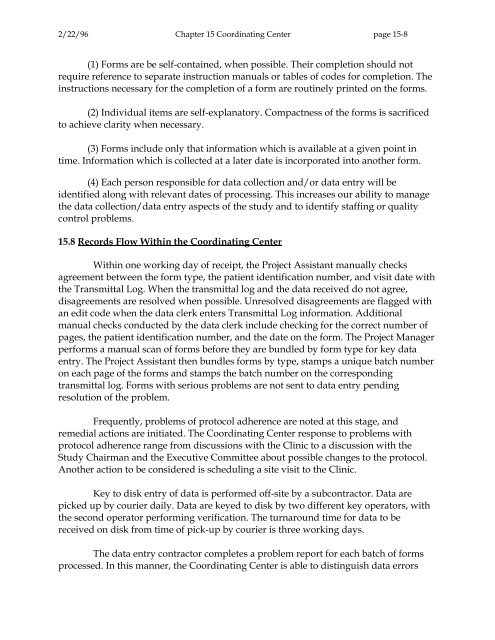OM t of c.iii - Vision Research Coordinating Center - Washington ...
OM t of c.iii - Vision Research Coordinating Center - Washington ...
OM t of c.iii - Vision Research Coordinating Center - Washington ...
You also want an ePaper? Increase the reach of your titles
YUMPU automatically turns print PDFs into web optimized ePapers that Google loves.
2/22/96 Chapter 15 <strong>Coordinating</strong> <strong>Center</strong> page 15-8<br />
(1) Forms are be self-contained, when possible. Their completion should not<br />
require reference to separate instruction manuals or tables <strong>of</strong> codes for completion. The<br />
instructions necessary for the completion <strong>of</strong> a form are routinely printed on the forms.<br />
(2) Individual items are self-explanatory. Compactness <strong>of</strong> the forms is sacrificed<br />
to achieve clarity when necessary.<br />
(3) Forms include only that information which is available at a given point in<br />
time. Information which is collected at a later date is incorporated into another form.<br />
(4) Each person responsible for data collection and/or data entry will be<br />
identified along with relevant dates <strong>of</strong> processing. This increases our ability to manage<br />
the data collection/data entry aspects <strong>of</strong> the study and to identify staffing or quality<br />
control problems.<br />
15.8 Records Flow Within the <strong>Coordinating</strong> <strong>Center</strong><br />
Within one working day <strong>of</strong> receipt, the Project Assistant manually checks<br />
agreement between the form type, the patient identification number, and visit date with<br />
the Transmittal Log. When the transmittal log and the data received do not agree,<br />
disagreements are resolved when possible. Unresolved disagreements are flagged with<br />
an edit code when the data clerk enters Transmittal Log information. Additional<br />
manual checks conducted by the data clerk include checking for the correct number <strong>of</strong><br />
pages, the patient identification number, and the date on the form. The Project Manager<br />
performs a manual scan <strong>of</strong> forms before they are bundled by form type for key data<br />
entry. The Project Assistant then bundles forms by type, stamps a unique batch number<br />
on each page <strong>of</strong> the forms and stamps the batch number on the corresponding<br />
transmittal log. Forms with serious problems are not sent to data entry pending<br />
resolution <strong>of</strong> the problem.<br />
Frequently, problems <strong>of</strong> protocol adherence are noted at this stage, and<br />
remedial actions are initiated. The <strong>Coordinating</strong> <strong>Center</strong> response to problems with<br />
protocol adherence range from discussions with the Clinic to a discussion with the<br />
Study Chairman and the Executive Committee about possible changes to the protocol.<br />
Another action to be considered is scheduling a site visit to the Clinic.<br />
Key to disk entry <strong>of</strong> data is performed <strong>of</strong>f-site by a subcontractor. Data are<br />
picked up by courier daily. Data are keyed to disk by two different key operators, with<br />
the second operator performing verification. The turnaround time for data to be<br />
received on disk from time <strong>of</strong> pick-up by courier is three working days.<br />
The data entry contractor completes a problem report for each batch <strong>of</strong> forms<br />
processed. In this manner, the <strong>Coordinating</strong> <strong>Center</strong> is able to distinguish data errors
















